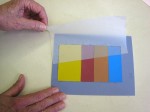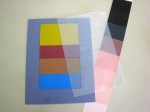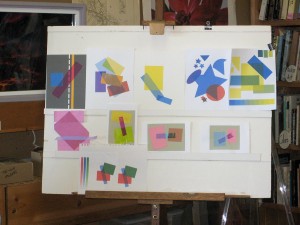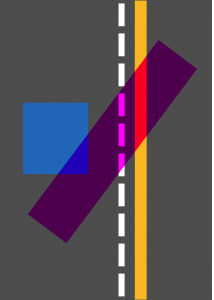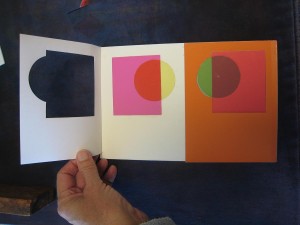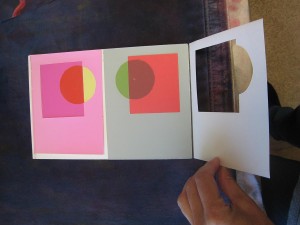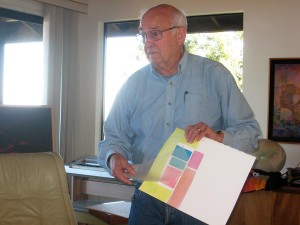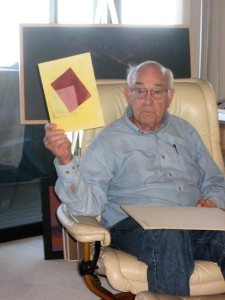The second session of the Color Relationships class for Winter 2015 was held on Friday, January 16. We critiqued the solutions to the film illusion assignment (Create the illusion of a colored film over two or more colors), and had an introduction to veils. The new homework assignment is to create the illusion of one or more veils over a set of two or more colors, incorporating an actual veil (a piece of tracing paper or the like) into the study. Films and veils are two visual phenomena that help to unify and create emotion in a piece, intriguing the viewer and inviting their participation.
Homework assignment
The new homework assignment is to create an illusion of a veil, as detailed below. In addition, be on the lookout for examples of veils in daily life, in artwork or photos, in magazines or on the web, to share next week. WikiArt.org is a convenient place to look for images of paintings. Check stock photo sites, Flickr, Facebook, etc. for examples from life, or better yet, take your own photos!
Here’s an example of a past student’s solution to this exercise:
Class recap – some key ideas
Critique – illusion of a film
- Homework solutions: Illusion of a film
- Checking the illusion with a real film
The assignment was to create the illusion of a colored film over two or more colors. The students found doing it, both in Illustrator and in opaque paper, challenged them to observe very carefully and critically, and to think about what colors were needed to make it look right. During critique, Dick helped the class recognize for themselves where the illusions were consistent and where they were ambiguous, and how the contrast of a film over a light color is greater than when it is placed over a darker color.
Regarding the composition of the studies, Dick commented, “I wonder whether you’re putting too many girders on the bridge. Can you say more with less? I think back to Albers – ‘Simplify, simplify.’ The most eloquent way to say it is the simplest.” He asked the students whether a more opaque or a more transparent film was more aesthetically pleasing to them, and suggested the notion of “whisper”. You’ll need to experiment with variations to incorporate films into your visual vocabulary.
Why study films? While creating these film illusions is almost magical, and Dick has always loved magic, the importance of knowing how to recreate the visual phenomenon of films goes beyond artistic sleight of hand. Shadows behave exactly like films, so an artist who recognizes that can create realistic shadows and convey time of day. It’s especially easy for a watercolorist, who can glaze with a single shadow color throughout a work. This contributes to unity and realism in a work. Beyond that, though, films can be used to set a mood. During the Baroque period, artists were interested in conveying emotion and life the way we perceive it. They discovered that glazing over a whole painting with an amber glaze would unify it, and create a warm ambiance, like at sunset. A film can unite colors that otherwise have no relationship and make them relate. In Dick’s opinion, only a fraction of the current artist population has any visual literacy in films. “Nature is relationship” and visually illiterate artists don’t see or convey natural relationships.
Multiple film illusions created by a past student, demonstrating the impact of context – surrounding colors.
All of the colors in this piece are solid, opaque colors. On the left, it looks like we’re seeing a squarish magenta film over a pink background and a yellow circle, because we don’t see any pink coming through the yellow, the pink is darker and more saturated under the square shape, and the circle looks red. On the right, it looks like we’re seeing a similar squarish magenta film over an orange background and a green circle, because there is no hint of orange coming through the green, and the orange is redder in the square shape and the green is toned to almost gray.
When the left-hand pink flap is lifted, we see a white background with a magenta rectangle, a red semi-circle, and a yellow semi-circle. There is still a film illusion, but it is ambiguous whether the magenta or yellow is the film, or both are, because we can sense white showing through both, but the magenta seems more solid and the yellow more transparent. When the right-hand orange flap is lifted, we see a pale green-gray background with a red square on it, and what appears to be a round green film over both. Here, the rectangle reads unambiguously as opaque because we do not sense any pale green showing through it, and the round shape reads as a green film because the portion over the pale green background is darker and more saturated, and the portion over the red is darker and more neutral.
Because the top background flaps have holes cut in them the shape of the overlapping square and circle, we are actually looking at the exact same colors with the flap closed and with it open, very effectively demonstrating how relative our perception of color is.
Introducing veils
Dick said that if you understood the film assignment, the next, veils, will be a snap. He asked for observations of veils “here, now”. Some answers included clouds, atmosphere, sheer curtains, vog.
- Observing a veil over a set of colors
- A past student’s veil illusion
A wedding veil is a familiar example of a veil. Why do brides wear them? They partially obscure, creating mystery. It captures our imagination. We can’t help but wonder what’s behind the veil. As an artist, you don’t have to spell everything out for the viewer. If you leave something to their imagination, it involves them more; they participate in the experience of the painting.
Dick talked about “reverse print” aloha shirts as an example of how veils can unify. They are purposely constructed with the bright print on the inside and the more muted “back” side of the fabric on the outside. The tinting effect harmonizes all of the colors, unifying the design. Notice the muted appearance of the shirts in the screen shot to the right.
There’s more emotion in a work when everything is unified. Films and veils are two visual phenomena that help to unify and create emotion in a piece, intriguing the viewer and inviting their participation.
Class materials
Here is the presentation on veils. Notice the parallels to, and differences from, films.

